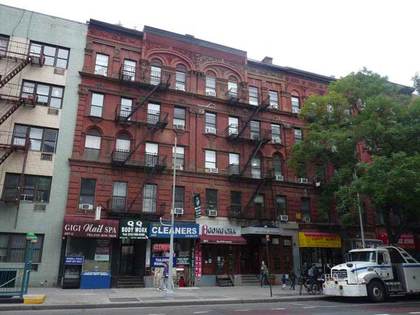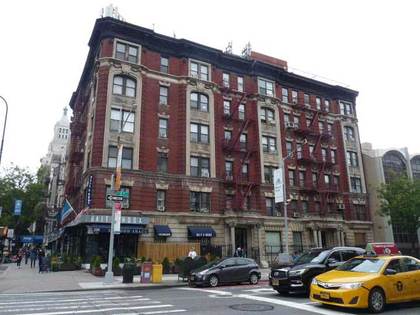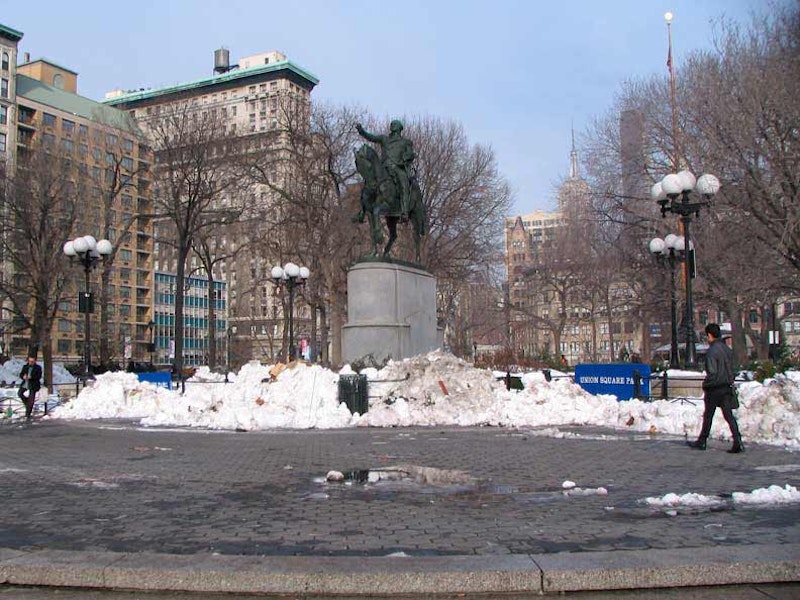Continued from Part One
Last week, I recalled a walk down 14th St., now mostly relieved of motorized traffic except for buses and emergency and delivery vehicles (except for local residents traveling one block) from 8th Ave. east to Union Square. I’ll go east from there.
My best photo of Henry Kirke Brown’s bronze of George Washington on horseback at Union Square’s south end facing E. 14th St. was taken just after a snowstorm. This was NYC’s first major outdoor portrait statue. It was just the second mounted statue produced in the USA, following Clark Mills’ Andrew Jackson in Washington, DC. This Washington portrays his reclamation of NYC from the British after their surrender in 1783, which was supposed to have taken place in the vicinity of where University Pl. meets 14th St. today. It was first set up in the middle of the intersection, protected from what was then mounted and wagon traffic by a fence, but it was moved to its current location facing E. 14th. The statue goes against mounted statuary tradition in that one horse’s leg raised usually indicates the rider died from wounds suffered on the battlefield; Washington died at Mount Vernon on December 14, 1799.

On the left at Union Square West and E. 14th is the Romanesque Lincoln Building, on the corner of Union Square West and E. 14th (that sounds impossible, but that’s how they name streets here). It was designated a NYC Landmark in 1988, and designed by architect R. H. Robertson 99 years before that. The buildings surrounding Union Square were designed at the dawn of the skyscraper era.
In the center is the Spingler Building, architects William H. Hume and Son, 1897. It originally contained stores, showrooms, manufacturers and industrial lofts. Note the tripartite style, an architectural sandwich: two floors with wide windows at the bottom, yellow-bricked center, and attic floor and cornice. The name harkens back to the Spingler House, a hotel formerly in the locale—a Henry Spingler owned much of the land here in the colonial era. Henry Spingler was a commercial gardener who lived at the end of the 18th century on the Bowery, at the corner of that thoroughfare and Broadway, now 15th Street and Union Square, and is buried in the churchyard of St. Mark’s in the Bowery at 2nd Ave. and E. 10th St.
The building on the right, the one that looks like metal and glass boxes stacked together—is the oldest of the group and was originally built in 1870 as the first Tiffany jewelry store in NYC. John Kellum designed what was at first an elaborate cast-iron fronted building. The Times called the new building a “palace of jewels,” with black-walnut counters and ebony cases holding watches, fans, opera glasses and other articles in wood, leather, silver, cloisonné, enamel, bronze and rosewood.

This large empty lot, on which a boring glassy tower for New York University has since appeared, replaced a PC Richard appliance store at E. 14th St. and Irving Place (named for author Washington Irving) was the former location of the famed German restaurant Luchow’s, which closed in the early-1980s. East of Luchow’s was the Palladium concert hall (which stared out in 1926 as the Academy Music Hall).
Though Tito Puente got the mambo craze started there in the 1950s, it was during the rock era that the Palladium made its name. The Academy Music Hall hosted the Stones, Beach Boys, Yes, Grateful Dead, Byrds, Fleetwood Mac, Lou Reed, Stooges, New York Dolls, Genesis, Springsteen, Frank Zappa and after a 1976 show by The Band it was rechristened The Palladium. I saw the Ramones on New Year’s Eve in 1979 here, the Pretenders when they were breaking in the spring of 1980 and the Pogues on St. Patrick’s Day in 1990 here among many other acts. The guitar-smashing shot on Clash London Calling LP was made here. The Palladium went away quietly in 1997.

East of 3rd Ave., E. 14th quiets down and becomes a retail-residential street. The block between 2nd and 3rd Aves. is by and large E. 14th’s only shaded block, with trees on both sides. Unlike the area east of Union Square, there are grand old apartment houses, too, including these constructed in the German Rundbogenstil or “round arch style.” This was a mid-19th century attempt in Germany to develop a national architectural style.

Beauty Bar, at #231 E. 14th, is unusual for two reasons: it’s a former beauty parlor that has been turned into a beauty-parlor-themed bar. The former Thomas Beauty Salon was converted in 1995. The building was constructed in 1921 as the Italian Labor Center, an organized labor/antifascist society. Above the entrance you find a pair of oddly sensual friezes by Onorio Ruotolo, depicting “a content family of working father, mother, and baby, the latter being cradled by his parents. The father holds a shovel in his left hand. The western panel illustrates the naked Roman goddess Minerva, patroness of craftspeople, next to a naked male child in the foreground before a shirtless laborer,” according to the 14th Street and Union Square Preservation Plan.

The apartment building at E. 14th and 2nd Ave. could logically be called NYC’s Senate building. Its two entrances are inscribed “The U.S. Senate” and “The W.M. Evarts.” Evarts was a Republican senator for NYS from 1885-1891, and that’s likely when the building went up. The developer must’ve been a friend of Evarts’. The senator’s grandson, Maxwell Evarts Perkins, who edited Thomas Wolfe and Ernest Hemingway at Scribner’s, was born in the building.

The Tifereth Israel Town & Village Conservative Synagogue has been located in this building at 334 E. 14th Street since 1962. However, the building itself is old: it was constructed as the First German Baptist Church in 1866 and then became a Ukrainian Orthodox church in 1928. It’s another example of German Rundbogenstil architecture. The onion domes were added in 1928 and 1962. The building was designated in 2014 by the NYC Landmarks Preservation Commission. “Tiferet,” or “tifereth,” is a word commonly found with many synagogues around town. It means “glory” or “splendor” in Hebrew.

Two doors down E. 14th at #340 is one of NYC’s oldest firefighting companies, Engine No. 5. The company has been in existence since 1865, and this building since 1880; it was designed by Napoleon LeBrun, one of the FDNY’s more prolific firehouse architects in its early days. Not only are there handsome active firehouses around town, there are also plenty of former firehouses that have been repurposed.

Stuyvesant Town sits on an almost-square defined by E. 14th and E. 20th St., 1st Ave. and Ave. C, with 89 buildings containing 8757 apartments. By auto it’s accessed by a series of ovals located on its four border streets, and pedestrians can easily access its four “quadrants” via the center oval. A second residential complex, Peter Cooper Village, sits north of E. 20th St.
I have a connection to Stuyvesant Town—my father worked here as a custodian for 30 years, between 1958 and 1988; he retired when he turned 70. This was an era in which unionized jobs with ample benefits were more attainable than now. He’d work the usual Monday through Friday, but occasionally would work the weekend and take Wednesday and Thursday off, on which days he’d see me off to school. It was a long way with two trains from Bay Ridge to Stuyvesant Town, so he’d leave the house at around seven a.m. or even before that, before I got up, usually arriving home around seven p.m. During snowstorms he’d need to go in at off hours to shovel snow.
I never visited Stuy-Town when he was working there (I do recall heading over there an evening or two by car when one of my father’s friends drove us there). The old man never helped put me on the famed list of people waiting for apartments to open up, but as he’d probably say now if he was still around, “You didn’t ask me!”

Speaking of repurposed houses of worship, the present Immaculate Conception Roman Catholic Church at #406 E. 14th St. near 1st Ave. was constructed in 1896 as the Grace Episcopal Chapel and Hospital; it was “converted” in 1943. This was a chapel for patrons of the main Grace Church at Broadway and E. 10th St. who could not afford the pew rates; in that era, many Protestant churches charged “rent” when you attended Sunday services. The parish itself was founded in 1855 by Archbishop “Dagger” John Hughes of the original St. Patrick’s Cathedral on Mulberry St.; the original church building was where Stuyvesant Town is now located.
—Kevin Walsh is the webmaster of the award-winning website Forgotten NY, and the author of the books Forgotten New York (HarperCollins, 2006) and also, with the Greater Astoria Historical Society, Forgotten Queens (Arcadia, 2013)

